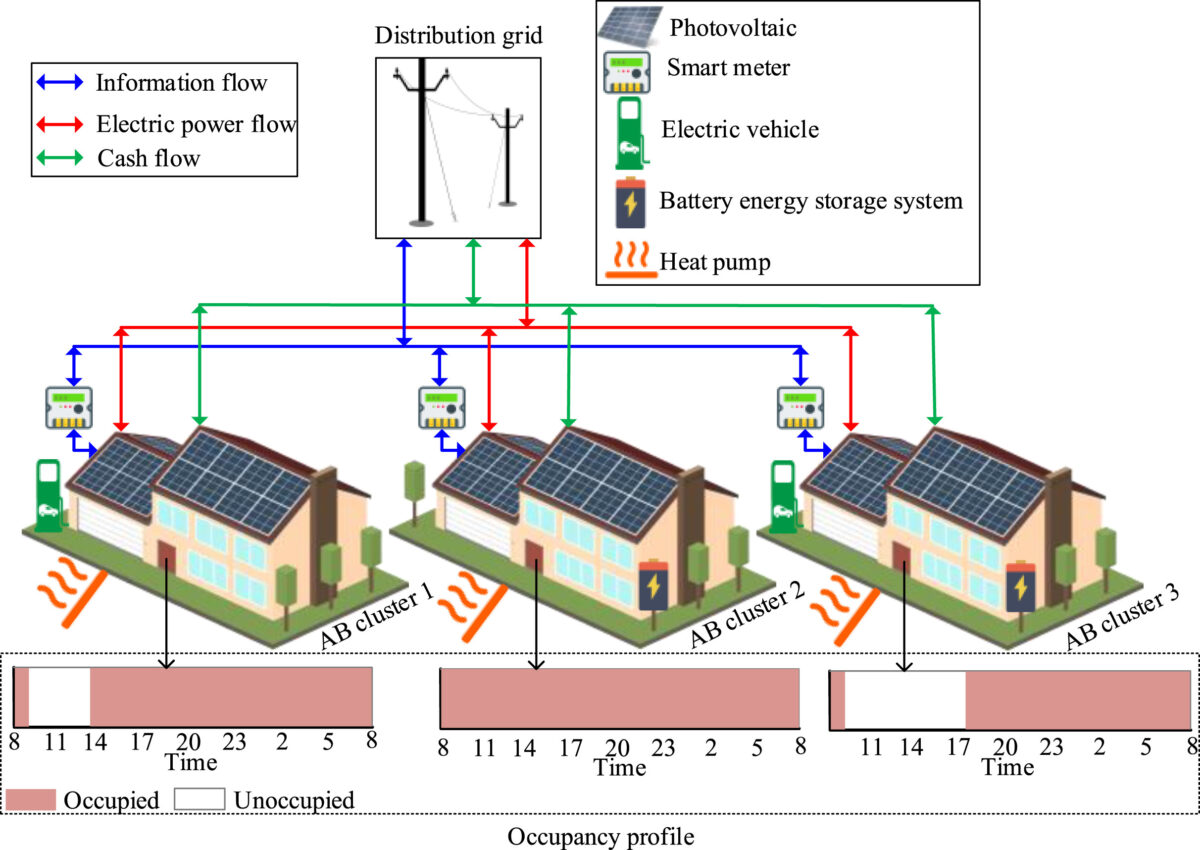A group of researchers from the United Kingdom has proposed a novel management strategy for building-to-building (B2B) energy trading in residential microgrids (RMGs). The new method incorporates occupant comfort levels and robust trading against uncertainty in occupant usage.
“Active buildings (ABs) are connected together through distribution lines. They can exchange energy, money, and information together and with the main grid,” said the scientists. “Under this community market, a controller collects the information from the ABs and incentivizes them to participate in the market by defining the local price signals. Therefore, price signals indirectly guide the ABs to participate in the B2B energy trading.”
To solve this optimization problem, the controller works on three levels. In its inner circle, optimization is conducted for each connected building without considering the B2B function, with the aim of achieving the lowest possible energy bills. Then, those results are used as a reference in the middle layer, which aims to incentivize the local market for lower costs. The third and final level takes into account the uncertainty in the preferences of occupants in terms of both thermal and lighting comfort.
“To do so, the information gap decision theory technique is utilized,” explained the academics. “The information gap decision theory presents an effective approach for characterizing uncertainties that lack substantial information and cannot be adequately modeled using probability distribution functions. Unlike stochastic and probabilistic methods, this approach does not necessitate extensive information about uncertain parameters and offers significantly reduced computational time.”
In this model, all houses have PV generation, heat pumps, and different home appliances such as washing machines and fridges. ABs are clustered into three groups: in the first, houses are unoccupied from 9:00 AM to 2:00 PM and include electric vehicles (EVs) that need to be charged. In the second cluster, the homes are occupied the whole day and have installed battery energy storage systems (BESSs). The third group's houses are unoccupied during office hours – 9:00 AM to 5:00 PM – and use both EVs and BESSs.

Image: Newcastle University, International Journal of Electrical Power & Energy Systems, CC BY 4.0
To test their novel management system, the scientist group ran it on a software simulation. The simulation included ten houses clustered into different groups and different home appliances. To evaluate the performances, they created four cases in the software, which were then compared.
“Case I is solved without consideration for B2B energy trading. Case II considered B2B energy trading and is solved in a deterministic environment,” the group said. “Case III considered B2B energy trading, but without consideration for occupant comfort. Case IV provides a robust solution where occupant comfort level is an uncertain input.”
Running an economic analysis on cases I and II revealed that participation in B2B trading lowers energy bills by 4.5%. The energy bill of case IV was found at £4.42 ($5.64), lower than case I, which resulted at £4.47. “This underscores the economic efficiency of our proposed method in achieving robust solutions at minimal cost, indicating that B2B can enhance the robustness of local control systems,” explained the academics.
Moreover, the finding showed that neglecting occupant comfort, as in case III, reduced the energy bill to £3.30. That is a 23% drop compared to case II, where the bill stood at £4.27. Further conducting a sensitivity analysis, the group found that the active building community needs to increase its total energy bill by 6% to achieve a 0.1% increase in the robustness against uncertainty of occupant comfort level.
“It is observed that enhancing the control mechanism’s robustness in response to occupant comfort level uncertainty entails a challenging decision-making process with significant budget implications,” concluded the research team. “It necessitates careful consideration by building community managers.”
Their findings were presented in “Building-to-building energy trading under the influence of occupant comfort,” published in the International Journal of Electrical Power and Energy Systems. The team included scientists from the United Kingdom’s Newcastle University, Northumbria University, and the University of Bristol.
This content is protected by copyright and may not be reused. If you want to cooperate with us and would like to reuse some of our content, please contact: editors@pv-magazine.com.



By submitting this form you agree to pv magazine using your data for the purposes of publishing your comment.
Your personal data will only be disclosed or otherwise transmitted to third parties for the purposes of spam filtering or if this is necessary for technical maintenance of the website. Any other transfer to third parties will not take place unless this is justified on the basis of applicable data protection regulations or if pv magazine is legally obliged to do so.
You may revoke this consent at any time with effect for the future, in which case your personal data will be deleted immediately. Otherwise, your data will be deleted if pv magazine has processed your request or the purpose of data storage is fulfilled.
Further information on data privacy can be found in our Data Protection Policy.